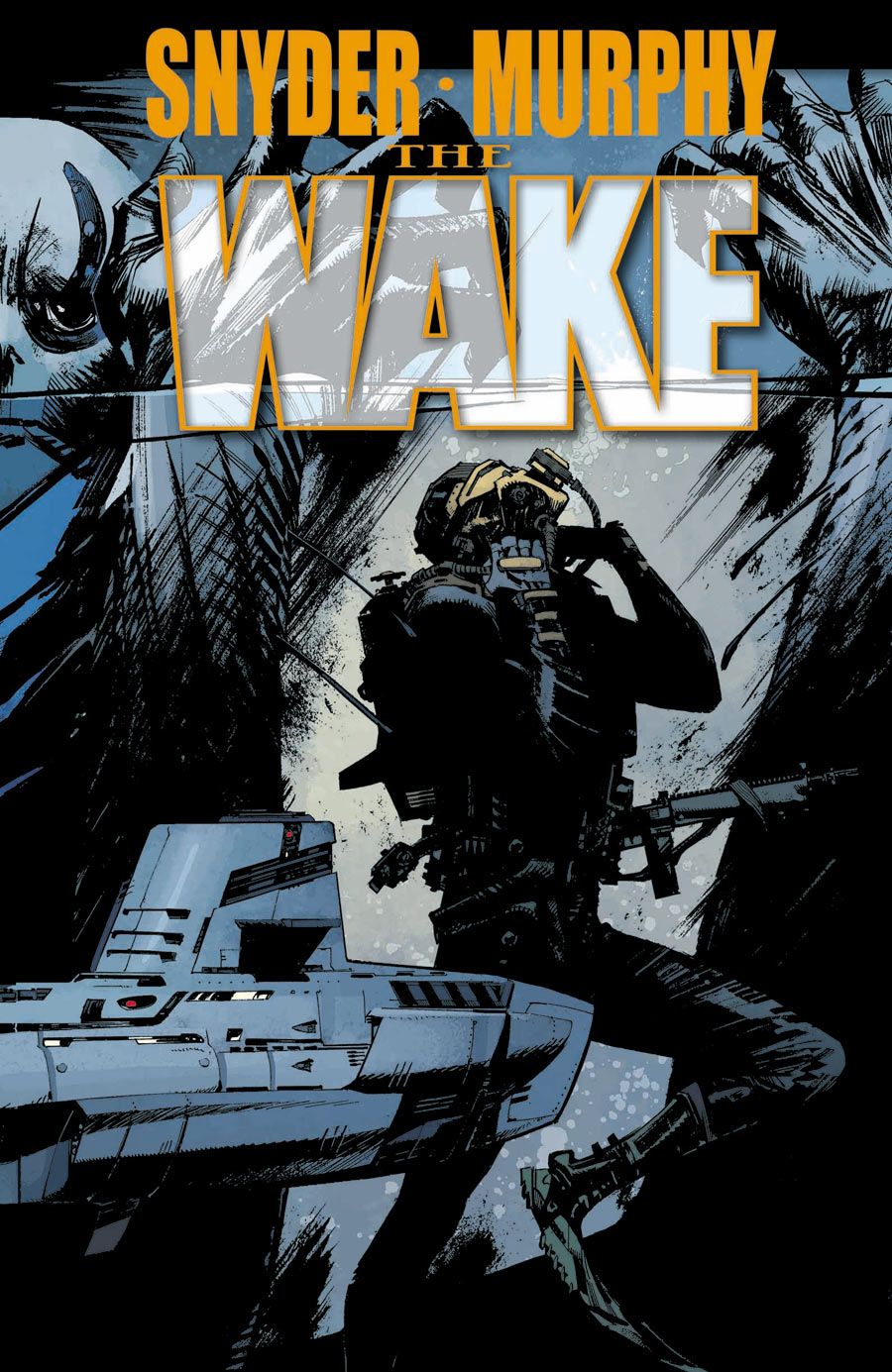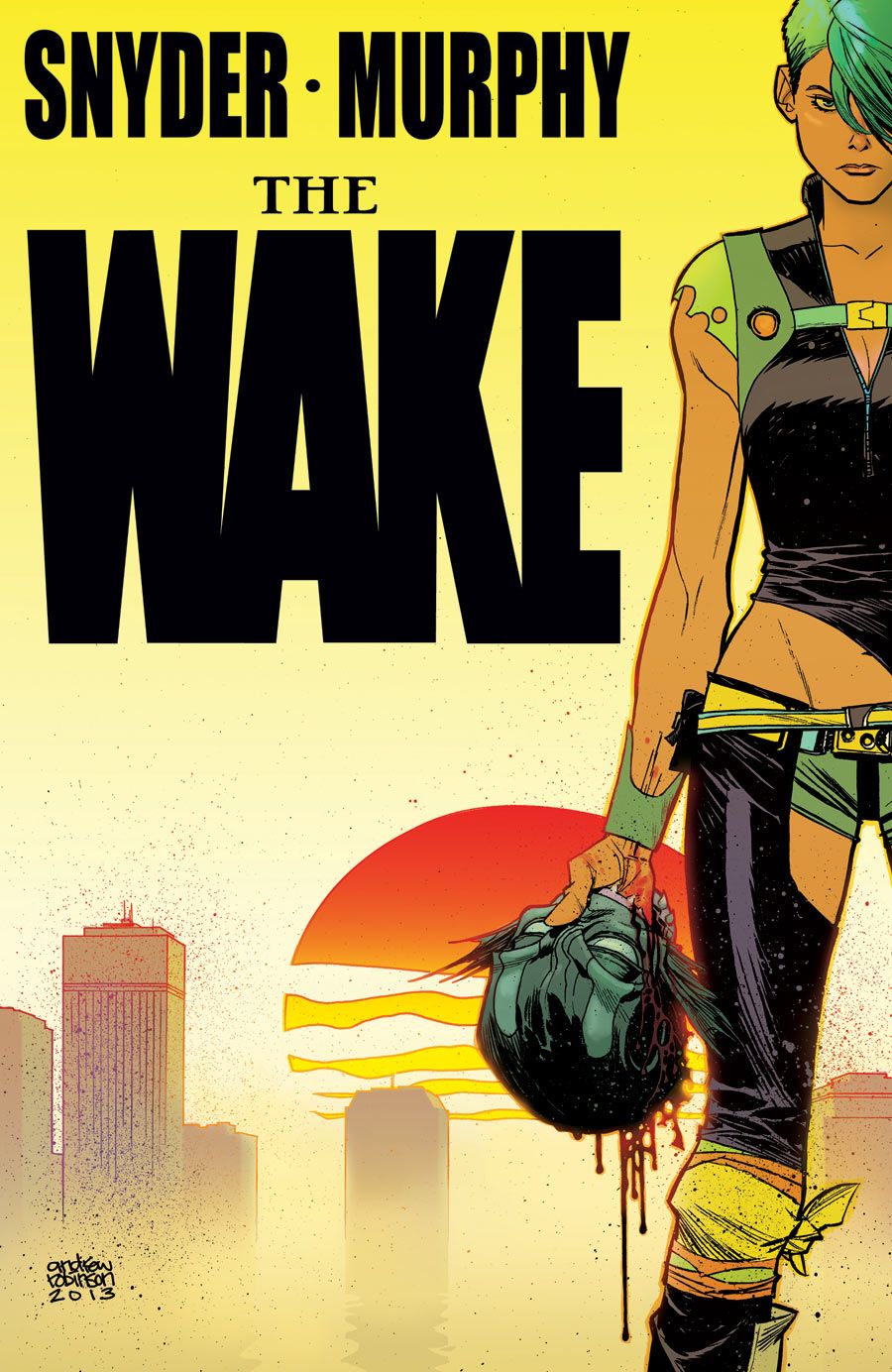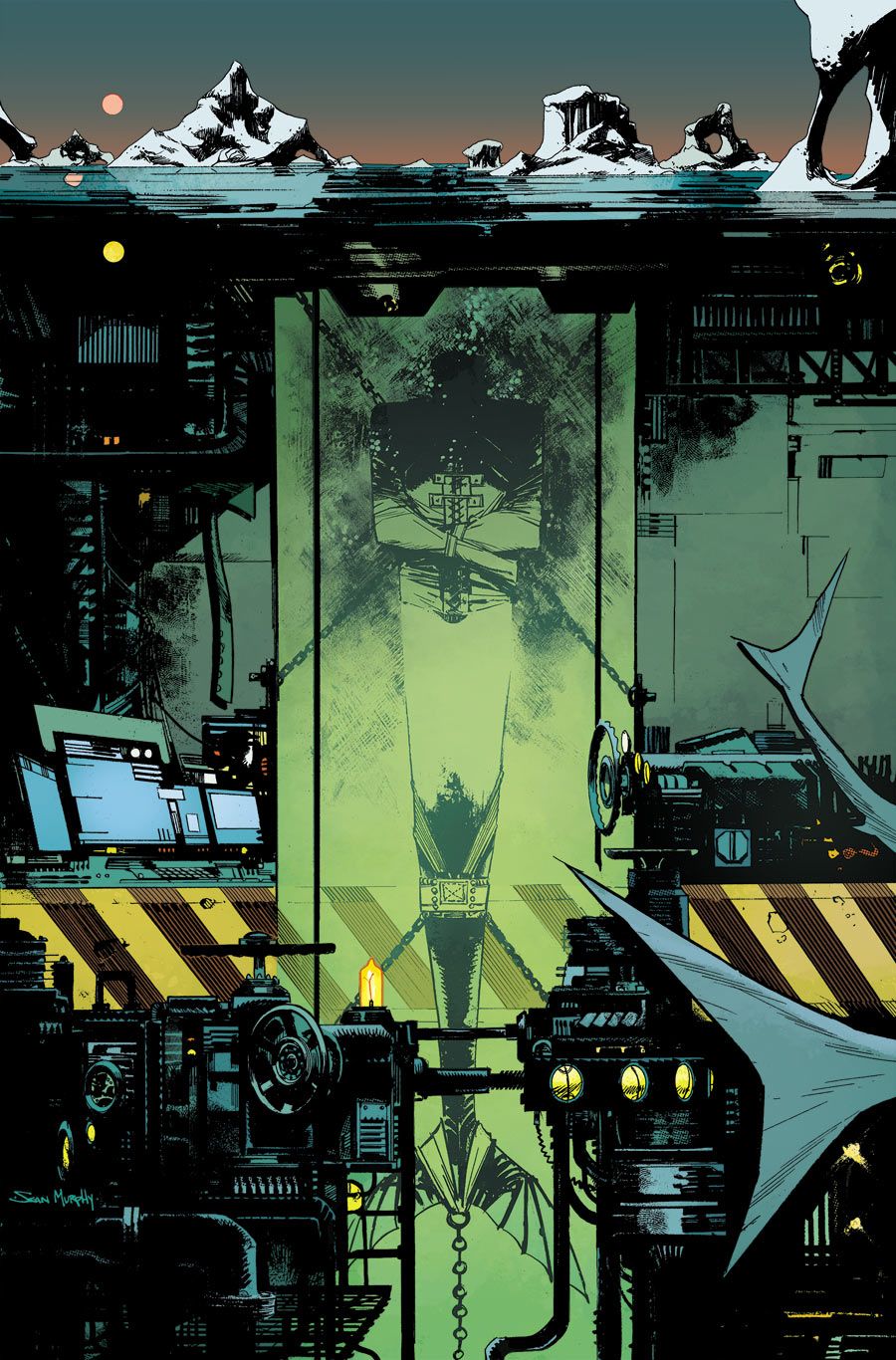Scott Snyder loves writing about things that go bump in the night. And the day. Or deep underwater. The best-selling writer of "Batman" and "American Vampire" has just completed the first part of "The Wake," a 10-part oceanic epic featuring art by Sean Murphy and published through Vertigo Comics.
In the game-changing fifth issue, Snyder and Murphy closed Part One of the series with a revelation of what's to come from the krakenesque creatures in Part Two to the apparent demise of the book's main character, its supporting cast and the world as we know it. And nobody feels fine.
Enter Leeward. Teased on the opening pages of "The Wake" #1, the spiked-hair heroine returned in the series on the final page of Issue #5, promising the start of her own story. As Leeward prepares to do battle with the monsters responsible for drowning her world, she must also live with the nightmare that the ever-rising waters, already hundreds of miles high, are filled with the demons she must face.
Following a two-month hiatus, "The Wake" #6 lands in stores on February 26, but if you haven't been reading the story and need to catch up, Vertigo is publishing "The Wake: Part One," which collects #1-5, on December 18.
CBR News connected with Snyder, who discussed his novel approach to breaking the series down into two distinct, yet totally intertwined stories, his inspiration for the project, what we need to know about Leeward heading into the back half of "The Wake" and enough biology and oceanography to get you through a Master's seminar course at Scripps.
CBR News: I really enjoyed "The Wake" -- listen to me; I sound like it's over, and we're only halfway there. Let me start again: "The Wake" #5 felt like a definite ending, but the last page, featuring Leeward, is obviously the start of something new. Was it always your plan to tell this story in two parts, in two distinct periods of time?
Scott Snyder: This is the first time I've actually been able to speak openly about the structure of the book. As much as I was tempted in some of the earlier interviews to say, "This is really two books and the second half is going to be this post-apocalyptic kind of epic," I couldn't really be so detailed or very open about that idea because we wanted the shock of the second half, at the end of the first half, to really resonate with people. It was always conceived as this two-book story. What we wanted was for people to be really shocked by the jump and how willing we were to completely turn the story on its head.
5-STAR REVIEW: Snyder & Murphy's "The Wake" #5
I think what will surprise people, in a good way, in the second half, is how incredibly different it is than the first half in terms of the world, the rules of the world and the scope of it in terms of its more imaginative elements. But also, how much of the first arc comes back in relevant ways. How they are not as separate as you think.
We are trying to do a fun trick where you get to the end of the first half and you say, "Oh, my God. I didn't see that coming." And in the second half, we are in a completely different story that has a totally different feel and totally different characters. That said, there are going to be a lot of surprises about how much of the first arc comes back into play in this one.
What world did you conceive first? The backstory featuring marine biologist Lee Archer and rest of the researchers facing off against the terrors of the deep, or the futuristic tale featuring Leeward, who I think resembles Lori Petty in "Tank Girl"?
Totally. [Laughs] It came together almost as one thing. It's hard to pick an exact moment, but it was sparked by the discovery of an ancient shark off the coast of Japan from a few years back. I saw a video of it on YouTube. At the time, I think it was 2007 or 2008, the idea that something so creepy could live down there and never be discovered until now or, not only that, but that it could still be alive and so clearly be a precursor, evolutionarily, to creatures that we know now, really got me thinking about how undiscovered the ocean really is. Reading up on how many different species, and I know they are predominantly small and miniscule creatures, are discovered in the ocean every year that we didn't even know about, I just thought how much fun it would be to do a story that really posited a kind of evolutionary ancestor of man down there. But then, I was like, "The discovery would be really fun, but what about if this thing was responsible for all of these myths and legends of floods and mermaids and krakens all of these cross-cultural happenings?" It hit me right away that this would be a great opportunity to not just have a creature captured, but put an end to the world and create an even bigger story.
From there, it became all about trying to boil down what interests me. What I try and do when I write a story, an arc or a miniseries or whatever it is, is try to figure out what it's really about for me. Meaning, once I have an idea that I think is a good premise, I try to unpack and think, "Why do I like this? Why is this hitting a nerve for me?" And for me, for this, it was this sense of learning about where you come from, but also being suddenly very bewildered by how displaced you are. The story really grew out of that notion. The live wire was that you learn evolutionary history. You learn the history of your country. You learn the history of your family, and yet, so much of the time, it's hard to wrap your mind around the smallest bit of it. You wind up feeling lost and homeless in this place even though you know, factually, how you got here. That sense of there being these mysteries that are epic and, I guess, revelatory, buried in the notion about human history and the history of life on the planet became what it was really about for me.
I did toy with the idea, and I actually started writing the first script as one that might have cut back and forth between the two worlds. But it just wasn't as effective, structurally. What would have been fun doing it that way, much like Jeff [Lemire] is doing with "Trillium," which I think works beautifully, would have been doing a dual story like we did in the first arc of "American Vampire." My thinking was that it would be riskier and more fun to do it this way. Do a two-book structure where, suddenly, you realize all of the characters that you were following are now gone, and you're with a new cast.
I'm glad you mentioned "American Vampire." In that book, you explained how an American vampire came into existence. In Robert Kirkman's "The Walking Dead," there is no explanation for the zombie apocalypse, and it doesn't really matter to the story. How about the monsters of "The Wake"? We will learn more about them in the second part of the story or doesn't it matter?
That's a good question. You're going to learn everything in the second arc of the miniseries. All of the questions that are raised in the first half, about the mysteries of the prehistoric times and the mysteries about the creatures and human history, all of it will come together at the end. There will be big revelations about all of it. It won't be a dream. [Laughs]
RELATED: Snyder Resurrects "American Vampire" with Albuquerque, Rides "The Wake" with Murphy
Right -- Archer doesn't wake up in the shower. [Laughs] You mentioned we see an all new cast in the second part of "The Wake" but are there traces, or at least mentions, of Parker and the rest of the crew, too?
I don't want to give it away. [Laughs] I don't want to spoil that because I think there should be some surprises in that department for everybody.
When you were developing the cast for "The Wake," and you knew you would tear them all away from us midway through the series, did that play into their development?
I remember seeing this lecture with Stephen King, and someone asked how he knew the story was over. He said, "When everyone is dead, of course." I'd like to think that I'm not that cruel, I'm not that much of a mercenary, but my feeling was that I knew it was going to be a short arc, and to develop characters that you attach to and like in five issues is a challenge. It wasn't about developing them to take them away; it was more about developing them so that you are looking forward to the next issue. Again, I don't want to spoil anything, but I think that you will be surprised in the ways that they echo through the second arc. Their actions and their memories and things like that keep them present.
There is a great page of art and storytelling midway through "The Wake" #5, which shows the history of major cataclysmic floods that have devastated civilizations dating back to 7th Century BC and the mythic times of Gilgamesh and the Great Deluge. Dr. Marin tells us what we've expected from Lee's flashbacks, but this isn't the first time the creatures have risen from the deep, is it?
Exactly. It's just that they have never had such a coordinated attack. The idea is that civilization wasn't as connected as it was today. They were the cause of these biblically-proportioned extinction events and floods, and the legends that were told to explain them, but they never needed the same massive, overwhelming attack. The world wasn't as overpopulated as it is now. It wasn't as connected, so this is the biggest attack ever.
You're working with Sean Murphy on this project and, not surprisingly, he's doing an awesome job. Was the plan always to have a mega-creature to lead all the smaller ones, or did he ask for it so he could draw it?
That was always the idea, because he told me wanted to draw a Godzilla kind of thing. Sean and I get along really, really well -- he's one of my closest friends outside of comics -- and we just joke around a lot about things that we want to get to write about or draw before we begin. For example, for "American Vampire: Survival of the Fittest," I had certain things that I knew I needed in that story. I needed Felicia and Cash to go somewhere together to supposedly find a cure for vampirism because they both have emotional reasons for looking for that. I needed it to be Nazis and needed the other beats that are important to the story.
Beyond that, I said to him, "What are some things that you want to draw?" And he said, "I want to draw Eastern European castles. And I want to draw motorcycles." I said, "Done." With "The Wake," there were a couple of things that he wanted to draw. He wanted to draw some cool submarines. He wanted to draw a big monster. And of all the things that we've talked about, the funniest thing is that the stuff that he's been dying to draw is in the second half, like cruise ships with a thousand oars sticking out of them. It's a flooded world. It's a redrawn America.
I want to go back to the first four or five pages of "The Wake" #1. Are those pages, which tease a massive wave crashing through a cityscape, the first few pages of the second part or the end of the second part?
It's further in. They're actually from about halfway through the second arc.
What can you tell us about Leeward?
She's the big heroine of the second arc. What I love about her is that she's someone that really feels in a lot of ways that the most important thing to do is look past the boundaries of your own life and what is circumscribed by them. She lives in an America that is about half the size of the country we have now, and it's shrinking every year -- the tide gets closer.
One of the things that was fun was doing the research on how absolutely flooded the world could be if you melted almost every ice cap. You would actually raise the sea level about 300 feet. You can't really melt the ice in Antarctica, because it's away from the sun all of the time and it's just too cold, so the idea is that the creatures carry the transatlantic current, the gulf stream, down there and the warm water in the current would begin to chip away at the ice. They would actually melt everything and raise the flood waters and, little by little, you push those waters in with a series of tides. The country is shrinking; it's very small comparatively. It's cut off. There is no connection to the rest of the world. Nobody knows if there is a rest of the world. The fun was to turn back the clock in a way so that it would feel like it would back in the days of oceanic exploration during the 1500s. Maps of that time were drawn with sea serpents and monsters on them because you didn't really know what lied ahead.
You end up creating a completely isolated and almost back-to-basics post-apocalyptic country and Leeward doesn't believe that this can be it. She feels that there has to be something more than a world that is shrinking constantly. The waters are encroaching, and your history's being washed away because everything is being destroyed. The water is pushing closer and closer. Leeward believes in the idea that there has to be a way to turn back the clock or do something to stop these creatures and reclaim the world somehow. She is determined to find out how.
And she's also really bad ass. [Laughs] I will give you one little tease: The creatures have a toxin in their glands that they excrete that makes you hallucinate before they kill you. She chops their heads off and sells them as opiates in the slums. [Laughs] She's really bad ass and she's one of the best hunters of these creatures around.
I want to close with what I believe was one of the first, if not the first, questions I ever asked you about "The Wake." What does the title mean, and does it mean something different as we head into Part Two?
Very much so. In the first part of the book, I think the idea of the title was the idea of waking up to this horrible realization and the truth of this horrible creature. In the second part, in a lot of ways, it's sort of a wake for the world. There's something funereal about the fact that everything has been washed away. At the same time, there's an even larger truth about how to save the world, if you're going to save it, that comes back very, very quickly. And you'll learn about what the great hope of the world is in the first issue of Part Two. It really does involve a kind of waking up of things, too.
I'm really happy with that title. My first impulse was to call it "Mermaids," because I thought that would be a sexy, dark, twisted title, but as we started writing it, I thought it was just too sensational and not layered enough for the story.
"The Wake" #6, by Scott Snyder and Sean Murphy, returns February 26. "The Wake" Part One, collecting #1-5, is scheduled to be released on December 18.




